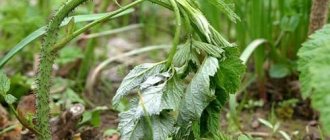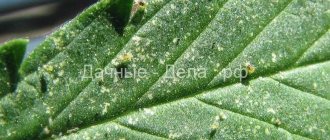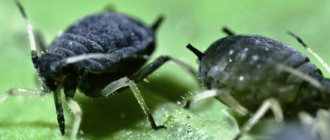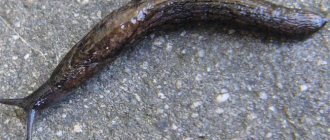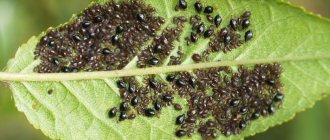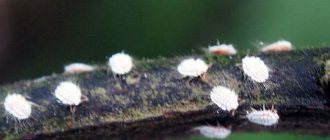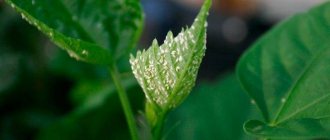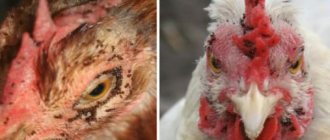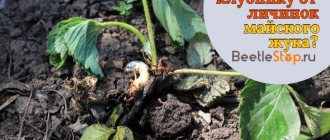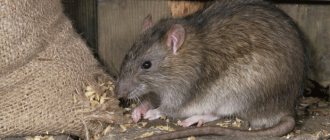carrot fly
All pests can be divided into 2 groups: omnivores that damage different crops and those that feed on plants of a certain species or one family.
The carrot fly has special preferences. She loves crops with aromatic root vegetables from the umbelliferous (celery) family - carrots, celery, parsley, fennel, parsnips .
Description of the pest
The carrot fly is a small insect 4–5 mm long, black with a green tint. Outwardly it resembles an ordinary fly. The large head is red-brown and covered with bristles. A dark spot is visible on the crown. The eyes are simple, large, oval shaped. The antennae are located under the forehead.
The insect's abdomen is oval. Wide and transparent wings of a greenish tint protrude far behind it. The legs of the fly are yellow.
Larvae have no head or legs. These are pale yellow shiny worms up to 5 mm long. In the bright sun they can sparkle like beads. The body is rounded at the front and narrowed at the back. On the last segment there are 2 short black processes with spiracles.
Pupae (puparia) are elongated oval brown in color, 4–5 mm long.
In our country, the pest is widespread in the Northern and Northwestern regions, in the Middle Zone, the Volga region and Siberia.
Description of the insect and the damage it causes
It is a member of the Psilidae family.
The size of the insect is 4-4.5 mm. The fly can be recognized by its black abdomen and chest, red head and yellow legs. The wings are transparent, oblong in shape and have brown veins. The damage to carrots is caused by larvae. Their length reaches 5 mm. The color is light yellow. The larvae resemble worms in appearance. They have no legs or heads. You can recognize insect-infected carrots by several signs of the disease :
- The leaves turn purple, then turn yellow and dry out.
- The passages made by the larvae appear on the root collar.
- The root crop becomes covered with tubercles. An unpleasant odor begins to emanate from him.
Life cycle
The carrot fly is prolific and produces 2–3 generations during the growing season . The pest begins in the spring during the May flowering of trees.
It is during this period that overwintered pupae turn into adults and begin to look for a place to lay eggs. Mating and egg laying takes 4–6 weeks. In the evening, females lay 100–200 pieces on the root collar of the plant or near the root at a distance of 0.5 cm from it . The pest never places the ovipositor in loose soil without nearby plants. Carrot fly eggs are oval, white, 0.5 mm long.
Carrot fly larvae
After 4–17 days, larvae emerge from the eggs, which immediately bore into the root crops and make tunnels inside . The first generation larvae develop in 20–25 days. Then they go into the soil to a depth of 4–10 cm and pupate.
The second generation of carrot flies appears in June-July. They are as active as the first generation insects. Their years last until mid-August. They lay eggs in thickened crops.
The larvae hatched from them feed on already ripened root crops. Having transformed from a larva into a pupa, the pest goes to winter. It is not afraid of frost and hides in the soil at a depth of up to 10 cm . Some of the larvae remain in the collected root crops. Together with them, it enters the vegetable storehouse and destroys the crop from the inside.
Seasonal and temperature factors
During the season, the fly makes two clutches : in May and at the end of July or August. She places eggs on the root collars of carrots:
- In warm weather (+20-24˚С), the new generation will hatch in 5-7 days.
- If cold weather sets in, this process will take about two weeks.
The larvae immediately begin to feed on the root crop.
After 3 weeks, the larvae climb into the soil to a depth of 10-20 cm to turn into pupae.
Signs and Symptoms of Carrot Infestation
Damage to carrots by carrot fly larvae
It is not easy to notice a small pest. He likes to hide in the tops and is invisible on the surface of the ground. The appearance of a pest is indicated by a change in leaf color. In affected carrots, the tops change from green to red-violet , and subsequently they turn yellow and dry out.
Root crops are covered with growths and bumps . They are drilled inside by larvae. Damaged tissue around the passages begins to rot . Infected root vegetables are poorly stored and lose their taste, become tough and bitter.
Signs of appearance
It is not difficult to recognize the appearance of a pest if you regularly inspect carrot crops. Some signs can be seen during growth, and some only after harvesting. It is worth studying how the carrot fly develops and when it appears, and fighting it will become easier and more effective.
The main signs of damage to plants by carrot flies:
- purple tint of leaves, yellowing and drying out;
- the visible part of the root crop acquires a purple tint;
- at the root collar you can see the passages of the larvae;
- the root crop begins to rot, crack, and rust-colored passages are visible on the cut;
- the pulp of the root vegetable becomes tanned, becomes tasteless or bitter, and acquires an unpleasant odor.
Reasons for the appearance of the pest on the site
The pest prefers shaded and damp areas . It settles where there is little light and a lot of moisture in the upper layer of the earth: in beds overgrown with weeds, in thickened plantings. Excessive watering and rainy weather contribute to soil waterlogging .
The insect is thermophilic. 16–18°C is the ideal air temperature to move around and actively search for food. Humidity, warmth, and the availability of food affect the fertility of females. When the humidity is 70–80% and the temperature rises to 17–20°C, the insect lays more eggs. During warm but dry weather, fertility decreases.
The carrot fly appears in areas by the smell emitted by umbrella crops . The more such plants in the garden and the denser the crops, the more attractive this place is for insects.
Prevention Tips
Do you carry out pest prevention in your area?
Of course! No, but I will!
To prevent crop damage from carrot fly, it is recommended to carry out the following preventive measures:
- Plant feather onions along the edge of the carrot bed. Its smell will repel the pest.
- Avoid fertilizing the soil with cow manure before sowing.
- Soak the seeds in a stimulating composition.
- Do not plant carrots in soil with organic fertilizers.
- Mix planting material with coarse sand for uniform sowing.
- Regularly loosen the soil to destroy insect eggs and larvae.
- Weed the beds in a timely manner.
- Covering the space between rows of carrots with peat will not only protect the crop from pests, but will also increase its yield.
The use of a variety of folk and industrial remedies will effectively combat carrot flies, and preventive measures will help prevent re-infestation by pests.
Means of struggle
Chemical and biological drugs
Arrivo
Enteric-contact insecticide with long-term protection. Dosage of the drug: 2 ml per 10 liters of water. After adding the emulsion to the water, the solution is thoroughly stirred.
Decis Lux
A universal drug that destroys insects at different stages of development with a high concentration of the active substance. Penetrates the pest's body after it eats the treated parts of the plant and causes its death. Doesn't wash off in the rain. To destroy carrot flies, prepare a solution at the rate of 5 ml of emulsion and 20 liters of water.
Aktara
Systemic drug based on thiamethoxam. This is a highly toxic drug, it is used while observing dosage and safety precautions.
1.4 g of insecticide is dissolved in 10 liters of water and sprayed on the plants. The death of the pest occurs on the first day after eating the treated aerial parts.
Fly eater
Granular product based on diazinon. Destroys adult insects and their larvae. Dry granules are placed between rows at the rate of 50 g per 1 square meter. m. Use only once during the season.
Prestige
The beds are watered with a solution of this drug after the first shoots appear, and the seeds are soaked in it before sowing. The consumption of the preparation for irrigation is 2 ml per 10 liters of water, the seeds are pickled for 6–8 hours in a solution of 1 ml of insecticide and 1 liter of water.
Phytocide
Biological product based on beneficial bacteria. Used to treat seeds before planting. The seeds are soaked for 1.5–2 hours in a solution prepared from 5–10 ml of the product and 0.5 liters of water. This product will protect future plants from pest attacks and fungal diseases.
Fitoverm
An effective natural preparation based on soil microorganisms. To treat carrot flour, prepare a solution of 2 ml and 1 liter of water.
An excellent result is achieved by the combined use of this drug and the bioinsecticide “Dachnik” (a natural product based on fir oil). Add 1 ml of “Dachnik” product to the prepared Fitoverma solution.
Traditional methods
During the summer period, the pest actively uses herbal medicines. Insects cannot tolerate many strong and pungent odors.
- 4 kg of crushed tomato stems and leaves are poured into 10 liters of water. Boil for 30 minutes, then leave for 3-4 hours. The infusion is filtered, liquid soap is added and the plants are sprayed.
- Finely chop 200–300 g of onion or garlic heads and pour 2 liters of boiling water. The concentrate is infused for a day and filtered. To treat plants, add water to the infusion to a volume of 10 liters and add liquid soap.
- The first shoots are sprayed with a vinegar solution; 2 tbsp are diluted in 8 liters of water. l vinegar essence.
- Marigolds, yarrow, and wormwood have good repellent properties. The bucket is filled with herbs and poured boiling water. Leave until the liquid cools and filter. The plantings are sprayed with a solution with the addition of liquid soap, and the slurry is spread between the beds.
Plants are treated with phytosolutions 2-3 times in the morning or evening with an interval of 5-7 days. The effect of the treatments lasts up to 5 days. These procedures are carried out until there is a massive pest invasion and only the first signs of infection are noticed.
- In the spring, the beds are watered with a solution of ammonia. 1–2 tbsp. spoons are poured into 10 liters of water. The pest will be repelled by the sharp smell of the drug, and for the plant such watering will be a nitrogen fertilizer.
- Naphthalene tablets give good results; they are laid out on the beds.
- During the egg-laying period, the row spacing is dusted with tobacco or mustard powder 2–3 times with an interval of 7 days at the rate of 1 tbsp. l per 1 sq. m.
- During the active summer of the carrot fly, baits are placed between the rows. Fermented bread kvass is poured into plastic bottles with the neck cut off. Insects attracted by the smell fall into the trap bottle.
- The carrot fly is a favorite delicacy of toads and frogs. They catch them with pleasure and eat to their fill. To attract them to the site, a home is set up for them in cool corners - a small pile of old firewood or boards.
How can you protect your garden in the future?
To protect the beds, the following methods should be used.
Special care measures
- In the fall, you need to dig up the soil to a depth of 20 cm. This will help destroy pests located in the soil (those in the soil and all other main pests of carrots are described in another article).
- Planting is carried out in a sunny area located on a slight hill.
- You need to adhere to crop rotation. Carrots are planted after green manure, potatoes, cabbage, zucchini, pumpkin, cucumbers, garlic or onions. The crop can be grown in the same place after 3 years.
- You need to plant onions or garlic next to the vegetable to repel insects.
- Overwatering should be avoided. Moisturize carrots once a week.
- The crop should not be fed with manure, as it may contain fly larvae.
- The plantings should not be allowed to become dense. Carrots are thinned at least 3 times during growth. The beds are mulched with peat.
Treatment with special preparations
- To destroy larvae in the soil, use:
- Fly eater (50 g per 1 m²);
- Bazudin (30 g per 20 m²);
- Provotox (4 g per 1 m²).
- The culture is sprayed with Actofit solution (10 ml per 5 liters of water).
- During the growing season, the plant is treated with Inta-Vir (1 tablet per 1 liter).
Using traps
You can make traps in different ways. One of them is the use of plastic bottles:
- Cut off the top of the container and turn it over so that the neck is at the bottom.
- Then they insert it into the bottle and pour bread kvass.
Insects will react to the smell and become trapped.
The bait can be made from pieces of paper or fabric. The material is lubricated with a mixture of equal parts of castor oil, honey and rosin, and then laid out on the beds.
Varieties resistant to carrot fly
For the pest, juicy and tasty root crops of cultivated plants are more attractive than coarse root crops with a low nutrient content of wild relatives.
Of all the plants in the family, carrots are most affected, followed by celery. Less commonly – parsnips, parsley, fennel, dill, caraway seeds.
It is important to choose the right pest-resistant variety. The basic rule in choosing is that the variety or hybrid must be zoned, since such plants are best adapted to the climatic conditions of a given region.
Resistant carrot varieties and hybrids include: Nantesskaya 4, Shantane, Losinoostrovskaya, Flakko, Vitaminnaya 5, Perfectsiya, Kalgeri F 1, Flyaway and Resistafly.
Of the celery varieties, Egor and the old Kornevoy Gribovsky have proven themselves well .
Agrotechnical methods
To protect vegetables, use some agronomist tricks. Follow these guidelines for growing carrots:
- Feed the crop in a timely manner.
- Plant the seeds early, which will help the sprouts grow stronger and gain strength to protect against various ailments and pests: start planting at the end of May, no later.
- Thin plants regularly or plant seeds as far apart as possible. Remember that insects often infest and breed in densely planted areas.
- Carrots like moderate watering. Do not allow moisture to accumulate in the ground or drought, otherwise a fly will appear or the crop will develop poorly.
Thinning carrots
Please note that crops infected with larvae are very difficult to protect, because carrots quickly begin to rot. After the pest is destroyed, the affected root crops remain twisted, dry and hard, and practically do not develop. The following tips will help protect carrots from flies:
- The ideal place for carrots is a small hill that is well lit by the sun.
- Plant seeds in beds where tomatoes, onions or garlic grew last year.
- You can sow carrots in the same place after 3 years.
- Choose varieties that are resistant to insect damage: for example, Vitamin 5, Perfection, Flakke, Calgary F1.
- When planting seedlings, do not use cow dung.
- Before planting, treat the seed with a growth stimulator and a solution against soil pests: biological products such as Trichodermin, Azotophyte are suitable.
- Mix non-granulated seeds with sand, then plant in moist soil.
- Regularly loosen the soil - this will prevent the spread of the pest: with this approach, not only adult individuals, but also their larvae are effectively eliminated.
- Remove non-viable plants: those affected by rot or damaged by pests. This method of fighting is mechanical.
- Weed out plants from the umbelliferous family: dandelion, clover, cherry, angelica, dill, caraway, celery, kupyr.
- Do not leave carrot tops near plantings.
- Use the method of mulching between rows using peat chips: take 300 g of product for 2 square meters. m of plantings.
Insect repellent
Remember that the fly does not like the aroma of some herbs and the pungent odors of onions, garlic, and spices. Here are some tips for preventing parasites:
- Plant green onions nearby.
- Regularly treat the beds with mustard powder, tobacco dust, black or red ground pepper: 1 tbsp. l. Mix one of these components with 1 kg of sand.
- Sprinkle the row spacing with onion and garlic peels.
- Plant sage, rosemary, and tobacco between carrots.
Green onions planted next to carrots
Carrot varieties resistant to carrot fly
If you want to protect your crop from fly invasion, buy varieties that are resistant to this parasite. The following types of carrots are suitable for the garden:
- Nantik Resistfile F1 is a hybrid that has a long shelf life, has excellent taste characteristics, and a high concentration of carotene.
- Nantes 4 - root vegetables 16 cm long, contain a large amount of sugars.
- Perfection - late carrots, long stored.
- Crispy F1 – early variety, root crops 16 cm long, 2-3 cm in diameter.
- Calgary F1 is a large carrot up to 23 cm long with excellent taste.
Protecting the harvest
Protection of carrots from carrot flies can be carried out using chemicals, but it will be much safer and more effective to carry out simple preventive measures that take into account the characteristics of the life cycle and biological methods of protection. Prevention and control of carrot flies using folk remedies can be no less effective.
The following rules of agricultural technology must be observed:
- crop rotation (alternation of crops);
- choose dry, sunny places for growing carrots;
- carry out sowing over several periods;
- sow seeds at a large distance to avoid thinning;
- loosen the rows;
- remove tops and other plant debris from the beds;
- Do not plant crops in large beds.
The main substance that makes carrots attractive to pests is chlorogenic acid. It is this substance that is responsible for the carrot aroma, and the stronger the smell, the greater the likelihood of damage to the crop. In large dense beds, ventilation is difficult, so a cloud of carrot aroma hangs over the crops, attracting all the surrounding insects. A strong aroma also appears during thinning of thickened crops.
To “beat off” the carrot aroma, before thinning, you can spray the above-ground part with a solution of red or black pepper (1 tablespoon per 10 liters of water), infusion of garlic, onion, pine needles or strong-smelling weeds (wormwood, yarrow, chamomile). You can pollinate the rows with tobacco dust, dry mustard, red and black pepper, and place wormwood sprigs or tomato tops between the plants. Unfortunately, this treatment for carrot flies is short-lived and must be carried out every 5-7 days.
Plant protection can begin even during sowing of seeds. To do this, in order to obtain rare crops, it is recommended to mix the seeds not with sand, but with tobacco dust. It is considered effective to add birch tar, infusions of garlic and onions to irrigation water.
It is good to alternate rows of carrots with rows of onions or spring garlic. Onion phytoncides can repel the main pest of carrots, and it, in turn, will help get rid of the onion fly.
To reduce the number of flies, you can use glue traps, containers filled with homemade kvass or other fermenting liquid, or ordinary pieces of cardboard greased with castor oil, rosin with honey or Vaseline.
If it is not possible to prepare herbal infusions, devote a lot of time to crops and the question of how to treat carrots against carrot flies remains relevant, you should use biological preparations such as “Actofit” or “Fitoverm”.
